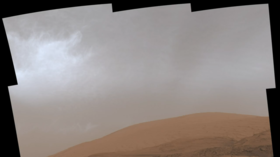Old rover looks at clouds: NASA’s Curiosity detects unusual atmospheric phenomena on Mars in pics of dry-ice puffs over Red Planet
The Curiosity rover has captured images of highly unusual atmospheric phenomena on Mars unlike anything on Earth – clouds that form so high that they mostly consist of crystalized CO2 instead of water.
Our neighboring planet is a dry, icy desert, but it still has some clouds in its thin atmosphere and they form often enough to affect its climate. Martian clouds differ from what we are used to on Earth, however, where common rain clouds are mostly comprised of suspended water droplets. On Mars, the clouds consist of tiny pieces of ice that crystalize around mineral dust particles, similar to so-called night shining clouds on Earth.
Two Earth years ago, NASA’s Curiosity rover spotted clouds passing by its location at an earlier time than expected. In March, as the Red Planet was passing through the same time of the Martian year, the veteran robotic explorer had its cameras ready to do some extensive imaging of the sky. The observations led to some unusual conclusions about the nature of the atmospheric phenomena, the team reported on Friday.
The clouds appeared to be freshly formed and traveling at a higher altitude than the usual cap of about 60km. The temperature in that region of the atmosphere is low enough for carbon dioxide to crystalize. So those clouds were most likely made of dry ice, rather than its regular water-based counterpart.
Solid carbon dioxide is not unusual on Mars. In fact, its polar caps, which consist of water ice, are covered by relatively thin layers of CO2 ice. On the northern pole, that cover evaporates during the summer season, while the one on the southern pole is permanent, though it varies in thickness depending on the season.

The clouds that Curiosity photographed were also notable for their spectacular iridescent colors, something one doesn’t encounter often on Mars. The ice crystals reflect sunlight from a setting sun and create a beautiful display.
“I always marvel at the colors that show up: reds and greens and blues and purples,” said Mark Lemmon, an atmospheric scientist with the Space Science Institute in Boulder, Colorado. “It’s really cool to see something shining with lots of color on Mars.”
Like this story? Share it with a friend!















